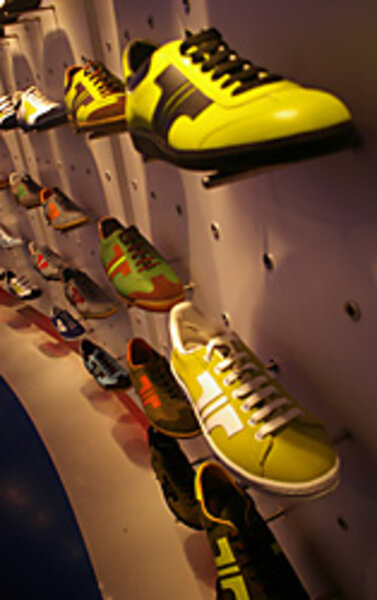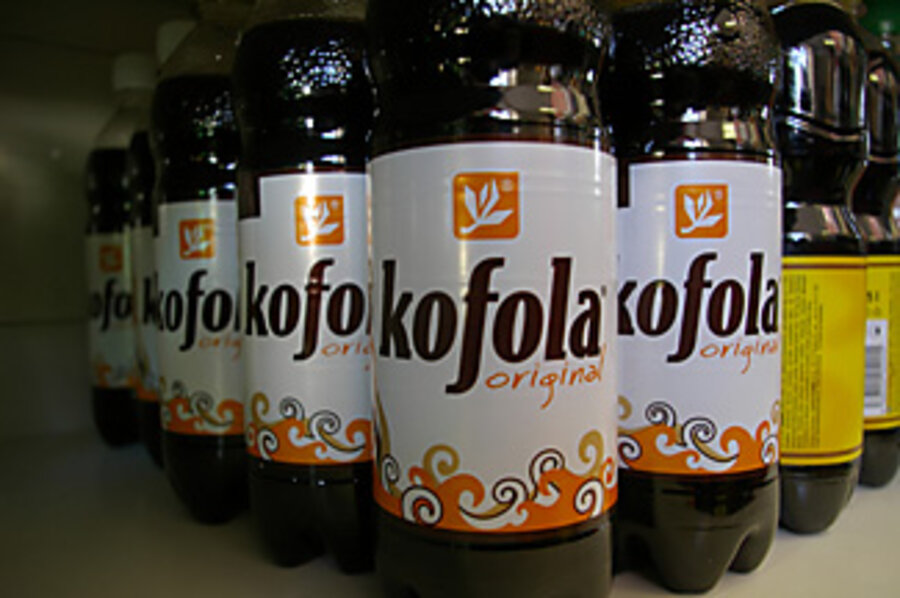Communist retro-chic: East-bloc icons win new status
| Komarno, Slovakia
At the Art Café, an enclosed gazebolike structure in the middle of a central square here, the multigenerational clientele lounges around talking and reading the papers. It's a scene that could be anywhere on the European continent, apart from one detail.
They're all drinking half-liter glasses of Kofola, a soft drink invented in the '60s to serve as Communist Czechoslovakia's substitute for Coke and Pepsi.
Nineteen years after the collapse of Communism, Kofola is in the midst of a renaissance. Far from being pushed aside by its Western competitors, it's outcompeting them. The not-so-sweet brown beverage is the top-selling soft drink in Slovakia, No. 2 in the Czech Republic.
"In the 1990s, Coke kicked in, in full force, but they never defeated Kofola," says Pavol Szalai, a 20-something magazine editor who prefers the old Communist brand. "It's very popular, especially in the countryside, because it's 'our' drink."
It's not an isolated phenomenon. In recent years, many of the countries of the old East bloc have discovered a newfound fondness for the brands, bands, and programs of the Communist period. Many homegrown products are challenging their Western rivals, a few decades later than the region's Communist apparatchiks hoped they would. Socialist-era rock bands and television shows have found a new fan base, while young professionals flock to restaurants and nightclubs modeled on the drab cafeterias and workers' hangouts of the '70s and early '80s.
"After 1989, the market opened and people wanted to try everything from the West," says Robert Parnica of the Open Society Archives, in Budapest. "Now people say, 'Why should I wear the uniforms of these multinational companies? Where are those things that were ours?' "
The phenomenon, which started in eastern Germany in the late 1990s and has since spread to Hungary, Poland, and the former Czechoslovakia, is often referred to by the German term Ostalgie, or "nostalgia for the East."
And while there are many East Europeans who pine for the economic security of the old system, scholars who study Ostalgie say it doesn't represent a desire to return to police states and one-party rule.
"It's a mixture of pop culture and social critique, a sort of language people use to express their disadvantages compared with the West," says Andreas Ludwig, director of the Documentation Center of Everyday Life in the German Democratic Republic in Eisenhüttenstadt, whose collection includes washing machines, baby carriages, and plastic living room sets from the former East Germany. "It's not about the past – it's very now."
Tisza trumps Nike
Fashions from the Polish People's Republic have made a comeback, along with the handful of Communist-era cafeterias and snack bars that hadn't been destroyed or remodeled during the transition. Product advertisements from state-owned firms have become collector's items, while the website of Slovakia's influential newspaper, SME, features a popular and extensive online library of images from the socialist period.
At Budapest's WestEnd shopping mall, trendy young Hungarians snap up boldly colored Tisza sneakers at the brand's upscale store. Under Communism, Tiszas were cheap, poorly made sneakers for the masses, meant to quench young Hungarians' appetite for Nike and Adidas athletic shoes from the capitalist side of the Iron Curtain. Now the shoes are not only back in production, they've become the retro-chic footwear of choice for Hungary's trendy youths, who eschew global brands in favor of a home-grown icon of an economic and political system few of them can remember.
Older people buy the products for nostalgic reasons, according to Kofola spokesman Martin Klofanda in Prague. "People remember Kofola from the old times, when we were very popular," he says. "Parents teach their children about it, which is why we're able to compete with the big brands from the West."
In Slovakia's capital, Bratislava, young people keep tabs on which hangouts provide the best Kofola on tap, which is a matter of freshness and maintaining the proper level of carbonated water in the mix. Mr. Szalai says the drink is so popular that "going out for a Kofola" is now shorthand for hanging out with friends in a cafe.
Ostalgie is also fueled by a reaction to the homogenizing tendencies of globalization and European Union membership, says Balazs Frida, a Budapest-based anthropologist who studies Ostalgie.
"There is a feeling of disappointment with the changes after 1989," he says. "Both the right and the left are talking about Americanization, Westernization, and cultural homogenization. Something like Tisza shoes is embraced because it's retro, it's Hungarian, and it's also a statement against the big corporate brands."
Not all decades are missed
The nostalgic feelings are also confined to the 1970s and '80s, a time when most East European regimes were liberalizing, allowing citizens greater freedom to acquire consumer goods, travel, and even voice mild criticism of the state.
"You could say and read what you wanted in the last four or five years of the dictatorship," says historian Maria Schmidt, director of the House of Terror Museum in Budapest, which documents the abuses of the Stalinist period, when life was grim and citizens lived in constant fear of the secret police.
"There's nostalgia for the '70s and '80s, and it's not bad to have good memories and look back at the movies and music of one's youth," says Ms. Schmidt, an outspoken critic of the Soviet-era regime. "Nobody in Hungary is nostalgic for the period from 1944 to the end of the 60s. Those were the darkest days."








